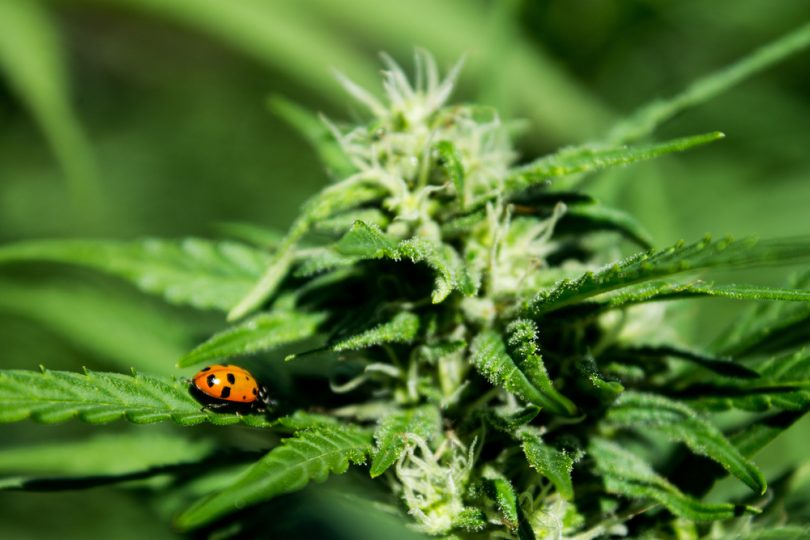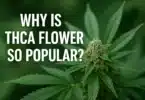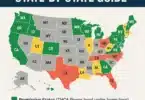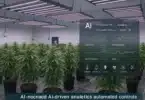Pesticides can be found on pretty much anything that’s grown these days. There’s an ongoing battle brewing regarding the dangers of these sprays to human health, with a growing collection of evidence in the negative category. Where does cannabis fit into all this? And what can you expect to have sprayed on your buds?
As with many topics in life, there is no official consensus on the safety/dangers of pesticides, especially when it comes to cannabis consumption, but the growing bank of literature expressing dangerous outcomes is hard to ignore. Nor is there a consensus on how much should be used, though the idea of needing to establish this is a strong indicator for the understanding of their collective dangers.
There aren’t consistently used ways to test for them, or even consistent regulation on what exactly is being tested for in order to establish the pesticide content. There isn’t a consensus on which pesticides are okay and which are not. One of the only things to be sure of, in fact, is that there’s probably something sprayed on your flowers, it might not be good stuff to have sprayed on your buds, and there could be a lot of it there.
To learn more about cannabis, subscribe to the Medical Cannabis Weekly Newsletter
Pesticides in the USA
In the US, the US Environmental Protection Agency (EPA) regulates pesticide use in agriculture with local governments overseeing the process. This accounts for any legally grown form of agriculture. Cannabis presents an issue in that it’s still federally illegal, apart from industrial hemp which technically is not intended for consumption.
This means there are no pesticides officially approved for use on cannabis for human consumption, and no official conversation about it at all. This also means there’s no official information being put out about safe levels of pesticide resins in products (if such a level exists). All states in the US that have legalized, have had to come up with their own regulatory systems, and without all the testing generally available on a federal level.
As of yet, all the legalized states have different policies, which means smoking cannabis, or using cannabis products, in/from these states would dictate different levels of regulatory safety.
A look at location specific laws for governing pesticides
California
California has done best so far to set a high standard for pesticide safety. Aided by the Department of Pesticide Regulation (DPR), California is often more stringent than the EPA. According to Charlotte Fadipe, a spokesperson for the DPR, “California drew on these resources to develop pesticide-residue limits for cannabis that it considers protective of public health…The process was anything but straightforward, however, given an almost total lack of reliable data on cannabis consumption in the state, subsequent pesticide exposure, and potential health effects associated with inhaling smoke or vapor from contaminated pot.”
According to California law, pesticides can be used on cannabis if the active ingredients meet specific criteria, like being exempt from Federal residue tolerance requirements, as well as being either registered for broad enough use to account for cannabis plants, or be exempt from federal requirements for registration. These requirements help push more organic solutions like neem oil and sulfur. However, as a state dedicated to its cannabis industry, California has not outright banned a lot of pesticides with more dangerous chemicals, preferring to set limits for pesticide residue on plants.
California Might Be Progressive with Marijuana, But CBD is an Entirely Different Story
Out of a list of 66 pesticides, California did cite 21 as being banned for cannabis use due to being classified as Category 1 pesticides – not registered for use with crops, or posing a threat to groundwater. Being found using these will keep a grower’s products from being sold. The other 45 chemicals each have their own level of allowable pesticide resins, separate for inhalable vs ingestible products.
If you’re thinking this means California has your health covered, keep in mind that one of the most frequently used pesticides on cannabis is Bifenthrin, which is used on many crops besides cannabis, and is already listed as a possible carcinogen, and endocrine disruptor in animal studies.
Washington State
Washington State is an example of the complete opposite to California. Not only have they still not implemented a good testing system – with progress effected by the coronavirus pandemic – but they’ve never required any kind of testing for adult-use cannabis since the inception of legal recreational marijuana in the state. The State does provide a list of pesticides approved for use with cannabis, but there is no standard for testing.
In fact, until its updated, the State only requires testing for potency (THC/CBD levels); mold, fungus, and bacteria contamination; mycotoxins (which are toxins produced by microorganisms); and moisture. Both pesticides and heavy-metals have been left out of testing for adult-use cannabis, and as of yet no update has been made.
Canada
Canada has had legal medical cannabis since 2001, years before its recreational market became legal. Realistically, accounting for pesticides shouldn’t be something that only comes up with legal markets, but as medical products are often regulated under different systems with different requirements, the entrance into a legal market is often an indicator of where regulation is lacking.
It wasn’t until 2017 that Canada started actively regulating pesticides, and it came on the heels of large recalls due to cannabis being grown with illegal pesticides, and finding large amounts of Piperonyl butoxide being used, which is expressly not allowed on cannabis plants. This led to an overall tightening of Canada’s policies regarding pesticide residue on cannabis.
‘Poor Quality’ Cannabis At The Root Of Canada’s Woes
As of July 2019, there are 29 pesticides that have been deemed legal to use with cannabis, according to Health Canada. Though there are some exceptions, the majority of pesticides approved in Canada are biological fungicides and herbicides that haven’t been known to cause as much damage to humans.
Some chemicals that have been approved for cultivating cannabis have specific limits set, and can be found on Health Canada Limits of Qualification table. These include more dangerous chemicals like Methoprene, dinotefuran, and chlorpyrifos, and require that they not show up in more than the quantities approved.
Since January 2nd of 2019, Canada stepped it up, requiring cannabis LPs to have their products tested by independent laboratories for 100 different chemicals.
Europe & Uruguay
The problem with Europe is that it has no legal recreational markets, and all legal smoking is done through loopholes, laws of tolerance, or medicinal legalizations, the latter of which generally come with their own regulations. This also means that regulation for pesticides might be lacking in some countries, and that dangerous amounts of it might be used regularly in cannabis production. It might require recreational markets opening up for the issue to become more clear in this region.
I also found almost nothing on Uruguay’s policies for cannabis pesticides apart from this: “IRCCA (so far) only authorizes cannabis with between two and nine percent THC and also tests for genetic specificity, mold, bacteria, pesticides, metals, etc.” This is hardly specific at all.
The Industrial Hemp Conundrum
The thing about industrial hemp is that it’s not meant for human consumption, and therefore not held to the same regulatory measures – anywhere – as a plant specifically for consumption. The issue that arises is when industrial hemp is used for consumption either illegally, or through loopholes. This article from December 2019 shows where this might start causing a problem.
Plant Hemp to Remove Contaminants and Revitalize the Earth
The article talks about the legalization of 10 pesticides for hemp in the US, making the statement that this is the first time (recently) that the US government has treated cannabis like a legal plant. The stipulation of course, is that industrial hemp is not meant for consumption, so the EPA wasn’t approving chemicals for a plant for consumption.
As the hemp industry grows, this list could very well grow with it, with much more toxic chemicals put on it. And while that technically makes sense, we already know that people often ingest industrial hemp, making it possibly dangerous to allow more harsh chemicals to be used.
Conclusion
It’s very clear that the issue of pesticides isn’t one that’s near and dear to the hearts of most cannabis users, whether recreational or medicinal. This in itself is a bit of a contradiction as the health benefits of cannabis are constantly being spoken about, and many measure have been taken to create safer smoking methods.
While people regularly switch to vaporizers and edibles from joints, pipes, and bongs to create a healthier cannabis-use situation, very few consider what might be sprayed on their cannabis, and the effects it could have on their health. This is similar to a person trying to be healthier by eating a lot of salad without considering the source of the vegetables. Those who are into organic know to consider these things.
The organic movement has been a powerful one, though often offset by misinformation, and the corporate organic market which tends to water down or bypass regulation (when you hear the term ‘know your brands’, this is why). Though organic for cannabis might not be the trend right now, I have no doubt that as the legal systems grow and expand, lower quality, higher chemical-laden cannabis will exist, but so will a top shelf organic option, which will likely be much more expensive, but offer one of the only ways to know what’s been sprayed (or hasn’t been sprayed) on your cannabis flowers.
Thanks for stopping by CBD TESTERS, your hub for all things cannabis-related. Stop by regularly and make sure to subscribe to the Medical Cannabis Weekly Newsletter to keep up-to-date on all the most interesting industry topics.
Resources:
The Endocannabinoid System Explained (Why Cannabis Is Good for Our Bodies)
Everything You Need To Know About CBD Isolate (a deep look into hemp extracts)
Not Just For Getting High (the underreported health benefits of THC)
Cannabinoids 101 – Spotlight on CBN (Cannabinol)
Your Complete Guide to EU GMP-Certified CBD Isolate and Distillate – Spotlight on the regulated EU market
Everything You Need To Know About CBG Isolate
Newest Cannabinoid Powerhouse – CBC – What Can It Do for You?
What is DELTA 8 THC (FAQ: Great resource to learn about DELTA 8THC)
DELTA 8 THC Medical Benefits (The medical background of using DELTA 8 THC products)
DELTA 8 THC Newsletter (The DELTA 8 THC Weekly Newsletter)
The CBD Flowers Weekly newsletter (your top resource for all things smokable hemp flowers)
The Medical Cannabis Weekly newsletter (International medical cannabis business report)
The Legal Landscape Of CBD Hemp Flower In Europe
Regulators Go After Smokable Hemp Flower – What Does The Future Hold?
The Complex Issue of Cannabis and Hemp Business On Tribal Land
Government Assistance Options for U.S. Hemp Farmers Affected By COVID-19







